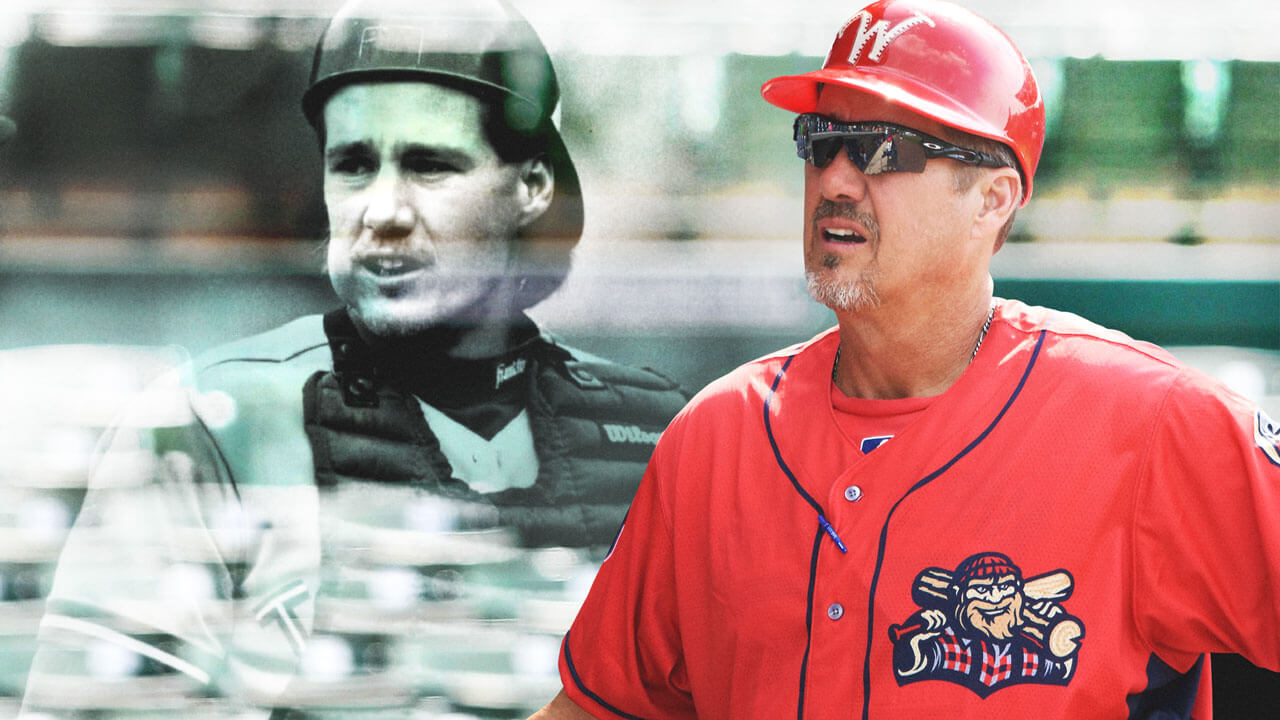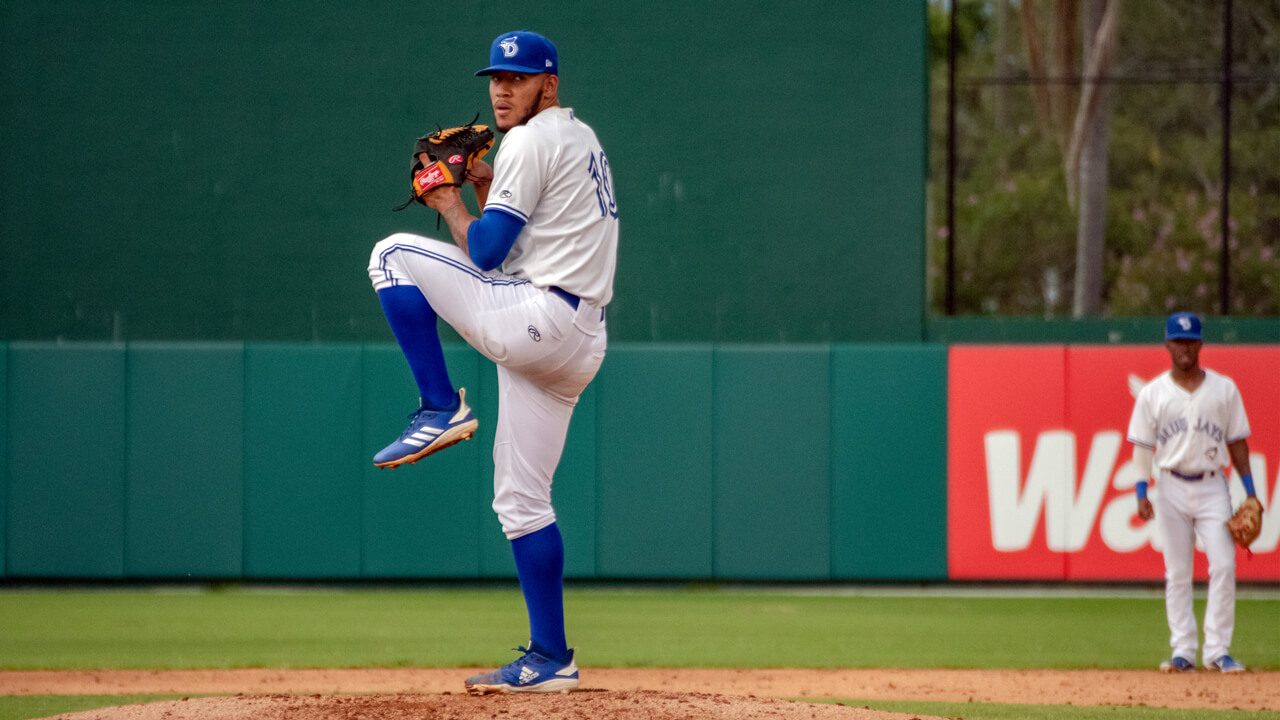For the 10th time in the plate appearance, Marcus Semien was squinting out towards the mound, waiting for his pitch. It was only the seventh game of the 2021 season for Semien and the Toronto Blue Jays, but they’d already found themselves in a rather tense spot — bottom of the 10th, automatic runner standing on second, tie game. Leading off the inning, a batter’s job in this scenario is simple: drive in the run at best, advance the runner at worst. Don’t waste the out.
But this wasn’t Semien’s night. He was already 0-for-4 with a couple of strikeouts, and at the end of his 10-pitch, six-minute, uphill battle with Los Angeles Angels reliever Junior Guerra, he swiped at a full-count splitter down-and-away, skipping a groundball to short. The runner at second was stuck, forced to retreat to his bag. Semien sprinted out of the box but was never going to beat the throw. Peeling off to his right beyond first base, he threw his head back in disgust.
There was a time in his life when Semien would’ve yelled, would’ve pouted, would’ve rocketed his helmet into the ground or halfway up the right field line. He lost his temper like that plenty when he was a kid. But then his parents pulled him from a game and told him he wasn’t going to play baseball anymore if that was how he’d behave. And it stuck with him through high school and college to today, in the pros, where he’s now a parent himself to three boys under five. Now, when he has those moments and the frustration rises, he looks for them in the crowd. “They’re my rock,” he says. “Any time something goes wrong in the game, I try and find them in the stands and it just centres me. It reminds me to keep my composure out on the field. Because I know who’s watching.”
He’ll find his boys — Isaiah, Joshua and Eli — with their mother, Tarah, who may just be the best athlete in the family. She was one of the top women’s volleyball players in the country as a teenager, went to the world championships with the U.S. youth national team, and was a two-time All-American who helped take the University of California, Berkeley to the national championship in 2010. After she graduated, Tarah played professionally overseas to support both herself and Marcus while he was grinding away in the minors until a knee injury ended her career. Their first child, Isaiah, was born not long after that.
“It’s a blessing to have my first child born in the East Bay and play for the Oakland A’s.” -Marcus Semien pic.twitter.com/2EVBhLA7Nf
— Oakland A’s (@Athletics) April 4, 2017
Now Isaiah’s nearly five and beyond impressionable. By the time he was two, he could emulate the batting stance of every one of his dad’s teammates with the Oakland Athletics. These days, he’s in the living room carving “Dios” in imaginary dirt like Vladimir Guerrero Jr. and leaning back with a big leg kick like Bo Bichette. Semien watches from the couch while studying video on his phone of the pitcher he’s going to face later that night. Inevitably, Isaiah hops up to join the session, asking his dad what he’s looking for so he can try to pick it up himself. “I put a game on and he’s, like, really watching it. He’s already a student of the game,” Semien says. “I’m proud of that — that my son loves what I do for a living.”
It is the one normal thing about this strange season for Semien — being with family. This February, they all packed up their things and moved across the country from California to Florida, where they’ve been finding a new rhythm in a Tampa suburb ever since. It’s been an adjustment. Outside of the four seasons he spent with the Chicago White Sox organization that drafted him, Semien’s lived his entire life in the Bay Area. He was born and raised in the diverse, hilly suburbs of El Cerrito; educated on Berkeley’s Beaux-Arts campus; and ultimately became an underdog success story as the everyday shortstop and heartbeat of the A’s, a small-budget franchise he helped win the AL West in 2020, reaching MLB’s post-season for a third year running.
Along the way he went from a below-average power threat with too much swing-and-miss to a 30-plus-homer leadoff hitter and MVP finalist. From an adequate utility player at best and defensive liability at worst to an above-average MLB shortstop and two-time Gold Glove runner-up. From a quiet, unassuming presence in a veteran A’s clubhouse to a leader who instilled a culture of work ethic and accountability atop an Oakland roster that considered him its unofficial captain.
He did it all in the only place he’s ever wanted to be. Where his family is; where his friends are; where he wants to live for the rest of his life. If it were up to him, he never would’ve left. But the A’s aren’t in the business of keeping players of Semien’s calibre around. Particularly not once they’ve accrued enough service time to increase their earning power. So now he’s a Toronto Blue Jay — happily so. And on Monday night, before a sparse, pandemic-limited crowd at RingCentral Coliseum — the decaying ballpark only 20 minutes from where he grew up, and the site of his off-season training throughout his MLB career — Semien will return to play his hometown team. It’ll be emotional. Not that he’ll let you see it.
“I’m excited. My parents, aunts, uncles, cousins — everyone’s excited,” he says. “They got to see me play every day for six years. And now it’s kind of like, ‘Where’s Marcus?’ So, it’s a big series for my family. A big series for me. I’m coming home.”

The only good thing about Campanile runs was that there weren’t many students up at 6:00 a.m. to see them. Twice a week, every week, the entire California Golden Bears baseball roster rose with the sun and gathered in front of their school’s mammoth Valley Life Sciences Building for conditioning. In full uniform, they’d sprint 400 metres up a gradual incline to Campanile Esplanade, where they’d touch the base of the campus’s iconic, 300-foot bell-and-clock tower and turn around. Repeat 25 times and you’re ready to head back to your dorm to grab breakfast and a shower before class. Or, if you’re Marcus Semien, to head over to the diamond for extra infield work.
“The tough part, honestly, was just getting your butt out of bed that early in the dorms when you don’t want to,” says Matt Flemer, who played four years at California, three of them alongside Semien, his best friend to this day. “For a lot of us, it was just a grind. But it never seemed to bother Marcus.”
How could it? Semien’s mother, Tracy White, was never bothered waking up early for classes in those same Berkeley dorms — even when she was pregnant with Marcus. White and Damien Semien, a Golden Bears wide receiver in the early ’90s, were sophomores when Marcus was born. His first daycare was in the campus’s University Village. His first football games were at California Memorial Stadium as a two-year-old, where he watched his not-so-old man catching passes opposite future Indianapolis Colts receiver Sean Dawkins.

After they left school, the couple went on to a humble Bay Area existence — Damien working at a juvenile hall, Tracy in insurance. They split not long after, leaving Marcus bouncing between homes in the San Francisco suburbs. He spent the majority of his time with Tracy in El Cerrito, often under the close eye of her mother, Carol Phillips. She’s the one who took him to A’s games as a child and supervised backyard tee-ball practice while Tracy and Damien worked long hours and built lives. Semien wears a pendant engraved with Carol’s thumbprint on a chain around his neck to this day.
Flemer first met Semien playing El Cerrito little league at seven. They were never on the same team, but both were more talented than most, which meant they got to know each other playing at all-star games after their seasons. They’d combine to throw no-hitters and try to one-up each other’s at-bats. For a couple of years, Semien lived across the street from El Cerrito’s Central Park, where the uneven, all-dirt infield turned groundballs into pinballs, and there were no fences — only a thin strip of concrete separating the edge of the outfield grass from somebody’s backyard. “It was an honour system,” Flemer says. “If you hit the concrete, it was a homer. That was probably a good 225, 250 feet out. It was a challenge to get one. But at 9, 10 years old, Marcus was out there getting them.”
Tracy and Damien made it to every practice and game they could, while Carol typically handled the weekend travel ball road trips. Flemer can’t remember a game without Carol sitting up the first base line. That continued at St. Mary’s High School, which Semien and Flemer both ended up attending. Semien played shooting guard for the St. Mary’s basketball team, reaching California’s state championship twice. That made him perpetually late for baseball season, but when he turned up, there was never any rust. He hit .397/.493/.684 over his four seasons, with more than twice as many walks as strikeouts. “He was always really talented — but he just got better and better every year,” Flemer says. “It’s one thing to have all that talent, but to work as hard as he did was pretty rare. No one ever had to push him or motivate him. It seemed like he just knew right away what it takes.”
That’s what stuck out to Adam Virchis, a Chicago White Sox scout covering northern California. Every time he checked in on Semien, the undersized shortstop had added something new to his game. One day he’d clock a little bit faster up the line. The next his arm looked stronger on throws deep in the hole. He was growing from plate appearance to plate appearance, making adjustments, laying off pitches he’d chased before. Virchis was so intrigued that he convinced Chicago’s west coast crosschecker, Derek Valenzuela, to cut short a Disneyland family vacation to come watch Semien play. Barely 6’0” tall with a slender build, he wasn’t an athletic specimen. But there was an unmistakable collection of character and makeup traits that make veteran scouts like Virchis want to bet on a player.
“To this day, he’s the nicest, most humble kid I’ve ever met. And I’ve been doing this for 20 years,” Virchis says. “He was so mature. The way he spoke, the way he carried himself, the head on his shoulders. Look, I’d be lying if I said I thought Marcus was going to be an MVP finalist. But I knew he was a great kid — a silent worker who would put his time in. And there’s no telling how far a kid like that can go.”
Semien grew up dreaming of following in his father’s footsteps in Golden Bears colours. Then both Flemer and Tarah, Semien’s girlfriend at the time and one of the nation’s top volleyball recruits, committed to play at the school. So, when his own California scholarship offer arrived, it didn’t take much consideration. Days before the 2008 MLB draft, Semien told the White Sox and other clubs courting him that he’d be heading to college unless he was offered life-changing money to sign. That slid him all the way to the 34th round, where the White Sox took a flier and offered Semien a signing bonus in the low six figures — an absurd number for the 1,020th-overall pick — trying to get lucky.
They weren’t. Months later, Semien was rooming with Flemer in the same California dorms his mom lived in while pregnant with him. Grades didn’t come easily at first; neither did playing time as Semien got into only half of California’s games as a freshman. But on the same days he was turning up in front of the Valley Life Sciences Building for conditioning as the sun rose, he was passing through its library doors to study as the sun set. And, with a willingness to play unfamiliar positions and fill a utility role on a rebuilding Golden Bears club, he earned every opportunity David Esquer — California’s head coach at the time — gave him.
“He was so fearless. We’d throw him out there at third base as a freshman, and he’d immediately get a ball that would be measured at 110 miles an hour — and he would not give an inch,” Esquer says. “That’s one of the reasons we moved him to shortstop. Because he did not flinch or move, no matter how tough the play. We had a couple other good players that could play up the middle. And it just became evident to us that he was the guy we needed at shortstop.”
Playing every day as a sophomore, Semien took off, hitting .328 with an .886 OPS. Esquer had challenged him to stop chasing the sliders that gave him fits his freshman year and work deeper counts, and Semien responded by reaching base in five of his first eight trips to the plate that season. His first homer of the year came off a slider. By Semien’s senior year, Esquer saw the still-undersized shortstop putting up the most competitive plate appearances on the team and installed him as his cleanup hitter ahead of bigger, stronger sluggers with more power.
“We asked a lot of him, and he accepted that responsibility and held himself up to a standard. He just had a presence. He had the slowest heartbeat in clutch situations,” Esquer says. “Talk about composed, poised, demeanour, unflappability — he just became that guy you could count on.”
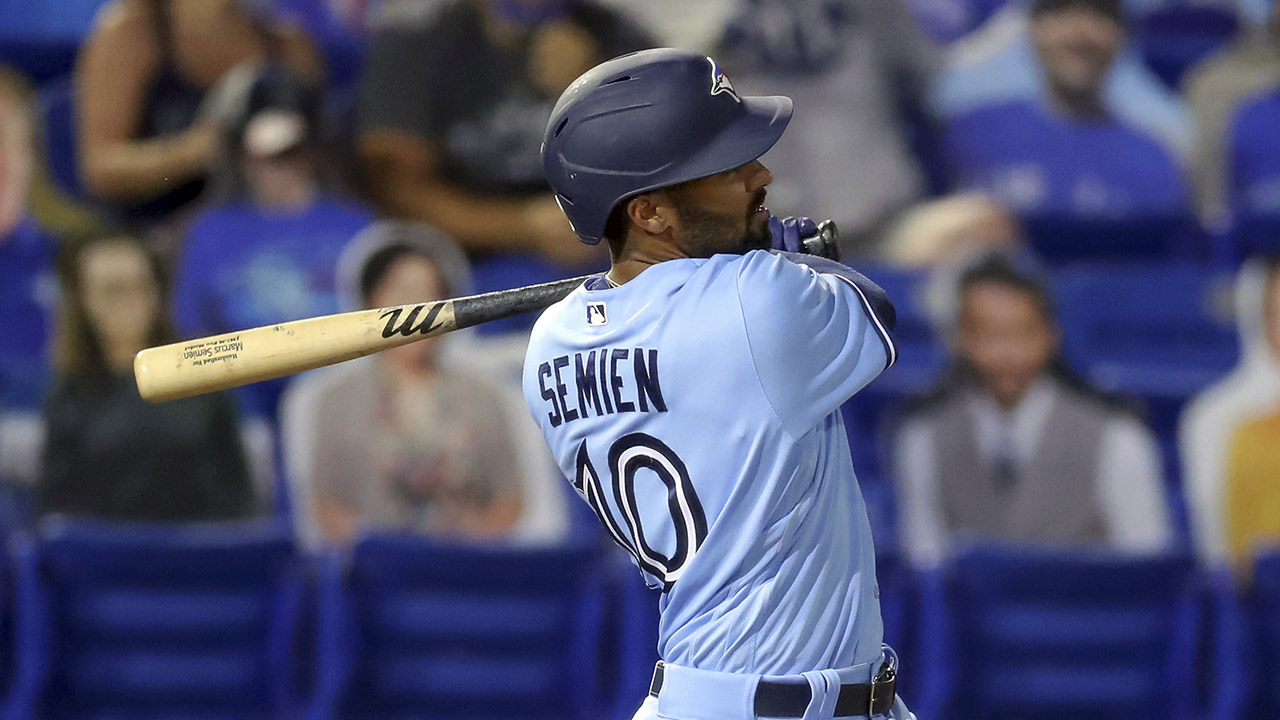
As he clicked the link in his email, conjuring that black Zoom preview box we’ve all become too familiar with, Semien wasn’t sure what to expect. It was a Sunday night this January, and after nearly 10 anxious weeks he felt like his free agency was finally getting somewhere. He’d reluctantly lessened his ambition of signing a multi-year contract to be someone’s starting shortstop — not because his desire had decreased, mind you, but because the opportunity wasn’t presenting itself. He’d begun entertaining the idea of a shorter-term deal and a possible position change. And that made the Blue Jays, one of the first teams to reach out as free agency opened, very interested.
So, a recruiting call was set up. Semien and Tarah logged in from their end and were met with a Brady Bunch checkerboard of Blue Jays personnel. There were the usual suspects, like Ross Atkins, the club’s GM, and Charlie Montoyo, its unfailingly sanguine manager. But there were also a couple of individuals you might not expect, such as Mike Murov, a director in the baseball operations department who grew up in the Oakland Hills, 15 minutes from where Semien went to high school. And Shannon Curley, the organization’s senior manager of player relations and community marketing.
In doing their background on Semien, the Blue Jays quickly learned how important his family’s living situation was to him, and that he’d want them with him wherever he was playing in 2021. That’s what made Curley’s presence of particular importance. As part of her role, she assists players and their families with the day-to-day logistics of moving to a new city. Finding somewhere to live; getting kids into daycares or schools; whatever’s needed to make life in an unfamiliar place a little easier. “Honestly, my family was the most important thing for me in making the decision,” Semien says. “I wanted that peace of mind that they’d be okay while I’m at the field.”
Murov added another layer. Years ago, he made the same transition from the Bay Area to Toronto that the Semiens were considering, and found the two locations weren’t so dissimilar. He spoke at length about the unique experiences a family can have within a quick drive of Toronto; how the city embraces people from diverse backgrounds; how everyone’s treated with empathy and respect, regardless of privilege. “That culture is something that’s very important to us. We come from a very diverse place, a very accepting place. That’s the kind of culture we want our kids to grow up around,” Semien says. “Honestly, through the whole free agency period, Tarah was pretty nervous. We had a newborn. It’s only a couple weeks until spring training, and we really didn’t know where we were going. With three kids, it’s hard. But that’s part of the business. Baseball families just have to deal with that.”
Of course, Semien wanted to stay in Oakland. But as his free agency developed, the A’s would only discuss a one-year deal at $12.5 million — a pay cut from the $13-million 2020 salary the two sides agreed to in Semien’s final year of arbitration — with most of that money deferred over the ensuing 10 years in $1-million installments, as the perpetually penny-pinching franchise sought to minimize expenses coming off a season without game-day revenue.
Meanwhile, the Minnesota Twins were talking to Semien about a one-year deal at $14 million with the opportunity to start at shortstop. The Los Angeles Dodgers were involved, as well, looking to make Semien their third baseman on a one-year pact. The Cincinnati Reds and San Francisco Giants called, too. He had options.
But the strongest interest came from the Blue Jays, who proposed a number of potential contract frameworks, including one as long as four years. The two sides couldn’t come to financial terms on a multi-year deal, but found common ground at one year and $18 million with the opportunity for him to keep playing up the middle. And as those negotiations neared the finish line, Semien, his conscience nagging him, instructed his representation to call the A’s one last time to see if they’d improve their offer. He wasn’t necessarily surprised by the response.
“That was just something I felt like I owed to my family. Not only my wife and kids, but my parents” Semien says. “And it didn’t work. But that’s totally fine. I understand the business. I understand where these owners are and what decisions they make right now because of the pandemic. And we just had to move on.”
You can tell he’d been preparing himself for this inevitability. But that Semien was only the latest in a dispiriting procession of franchise cornerstones to depart the A’s — owned by Gap heir John Fisher, whose estimated net worth is $3.4 billion — as soon as their salaries were deemed too expensive to tolerate did not make it any easier. Certainly not for A’s fans, and not for the Bay Area at large. Semien wasn’t just a representative of the A’s; he was a representative of Oakland. He wasn’t adopted by the community; he was born and raised within it. It didn’t have to be this way.
“There was a big part of him that was disappointed to leave Oakland. And everyone here — the fans, the community — was really disappointed, too,” says Flemer, who’s now the Golden Bears’ pitching coach. “He’s had such a big impact on the A’s and on this area. It was like our neighborhood would go watch him play. Our community would go watch him play. He was from our backyard. So, for a lot of people, seeing him go was really heartbreaking.”
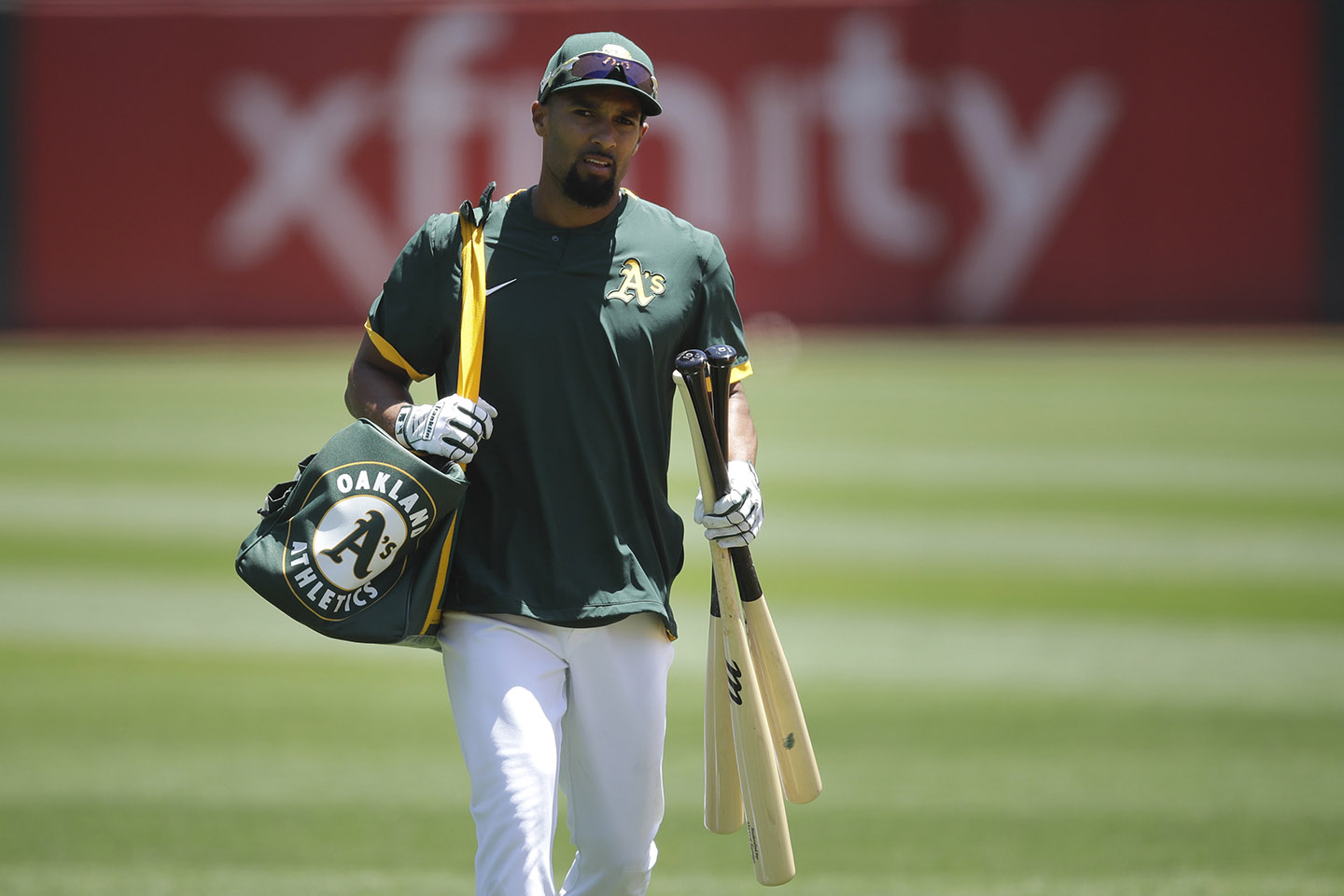
The glow of David Buscovich’s phone illuminated his dark bedroom a few minutes before 5:00 a.m., as a series of texts from Marcus Semien flowed in. Their workout wasn’t supposed to begin for another 90 minutes or so, but Semien was already up. Actually, he was already in the RingCentral Coliseum visitors’ weight room, its 54-year-old pipes leaking from above, flicking on the lights.
That was a regular occurrence this past winter for Buscovich, Semien’s former California teammate and off-season training partner since he turned pro. His alarm was set for 5:30 every morning so that he could meet Semien at the Coliseum an hour later to spot his lifts and throw him batting practice. But some days a 5:30 wakeup just meant he was late. Some days, by the time the Oakland sun was rising around 7:30, Semien was leaving the ballpark, nearly three hours of work in the books, and heading home to make his kids breakfast. And once he’d fulfilled his dad duties, Semien was hopping back in his car and returning to the Coliseum for more. “He doesn’t take days off. That’s his mentality — he checks every box,” Buscovich says. “The only thing he lacks is sleep.”
Semien and Buscovich first met playing travel ball when they were 15. Flemer played for the same organization, too. Eventually, they were all reunited at California years later when Buscovich transferred from junior college. And as Semien made the leap to the pros, he kept the same circle. This is how he operates. No private hitting coaches. No trips to fly-over state training labs promising to tap into unrealized potential in his game. Same routines; same facilities he’s always trained at; same guys he grew up with. “He’s been the same dude for the 24 years I’ve known him. And that’s with everyone,” Flemer says. “If you’re in his circle, he’s always there for you. He’ll always keep in touch. He’ll always check in on you.”
Of course, this winter was a little different due to the pandemic and the Semiens having their third son in January. But Buscovich and Semien still worked out five days a week throughout the off-season, throwing weight up in the Coliseum gym before going through an extended routine of 150 to 200 swings in the batting cages and eventually heading out to the field to take groundballs and run sprints. Some days, when Semien wanted more work, they’d return to the cages after the cardio to hit some more. “A big thing for me is just getting in the weight room every day,” Semien says. “Not necessarily lifting 400 pounds every day — but keeping your body healthy. Stretching, glute strength, core strength — all the things that make your body work. You have to stay on it.”
This is what it’s taken for Semien to get where he is. He’s a product of onerous, uncompromising work. When Virchis, the White Sox scout, convinced his organization to select Semien a second time — in the sixth round of the 2011 draft for a $130,000 bonus that was actually less than what the organization offered him to sign out of high school — his argument wasn’t that they were acquiring a can’t-miss prospect. It was that this kid would work hard enough to turn himself into something useful. A plug-and-play super-utility type at least. Maybe they’d get lucky and he’d become something more. The industry certainly wasn’t sold. In ranking Semien as Chicago’s No. 14 prospect ahead of the 2013 season, Baseball America said, “scouts are still skeptical about his bat, questioning his strength and whether he’ll get on base enough to bat anywhere but the bottom of the lineup.”
All Semien did that season was hit 15 homers with a .420 OBP in 105 double-A games, put up an .802 OPS during a brief triple-A stop, and make his major-league debut with the White Sox in September, getting a hit off a late-prime CC Sabathia in his first plate appearance. He won a job as Chicago’s everyday second baseman the following spring, and, after a so-so, up-and-down season, was traded to his hometown team as part of a package for Jeff Samardzija.
Installed as Oakland’s starting shortstop from the day he arrived, Semien had his streaks and his slumps throughout 2015, ultimately producing league-average production for his position in the aggregate. He lacked consistency, but there were glimmers. A two-homer night in Seattle; a torrid, 22-for-56 stretch in mid-May; a strong, .830-OPS finish over the season’s final two months. The problem was the slumps he’d experience in between. But the A’s, rebuilding at the time, had plenty of runway to give Semien as he worked through some things at the big-league level. His power arrived the following season, when he finished third among MLB shortstops with 27 bombs. And although it declined over the ensuing two years, as he battled a wrist injury, an oblique issue and various other nagging ailments he insisted on playing through, Semien was instrumental in the A’s emerging from an overnight rebuild and reaching the American League Wild Card game in 2018.
Then, 2019 happened. Semen started the year on a tear with 25 hits through the season’s first three weeks — a typical, pan-flash hot streak for him that was just as familiar as the funk that followed in May, when he had a .655 OPS for the month. But then he heated back up in June. And this time, rather than crash-landing back to earth, Semien just kept going. An .826 June OPS gave way to a .942 mark in July and .958 in August. There was a 17-game hit streak; a 1.147 OPS with runners in scoring position; a game against Texas with three hits and three walks; a day in Kansas City when he drove in seven. The only thing that stopped him was the conclusion of Oakland’s schedule, as he hit .347/.441/.693 in September.
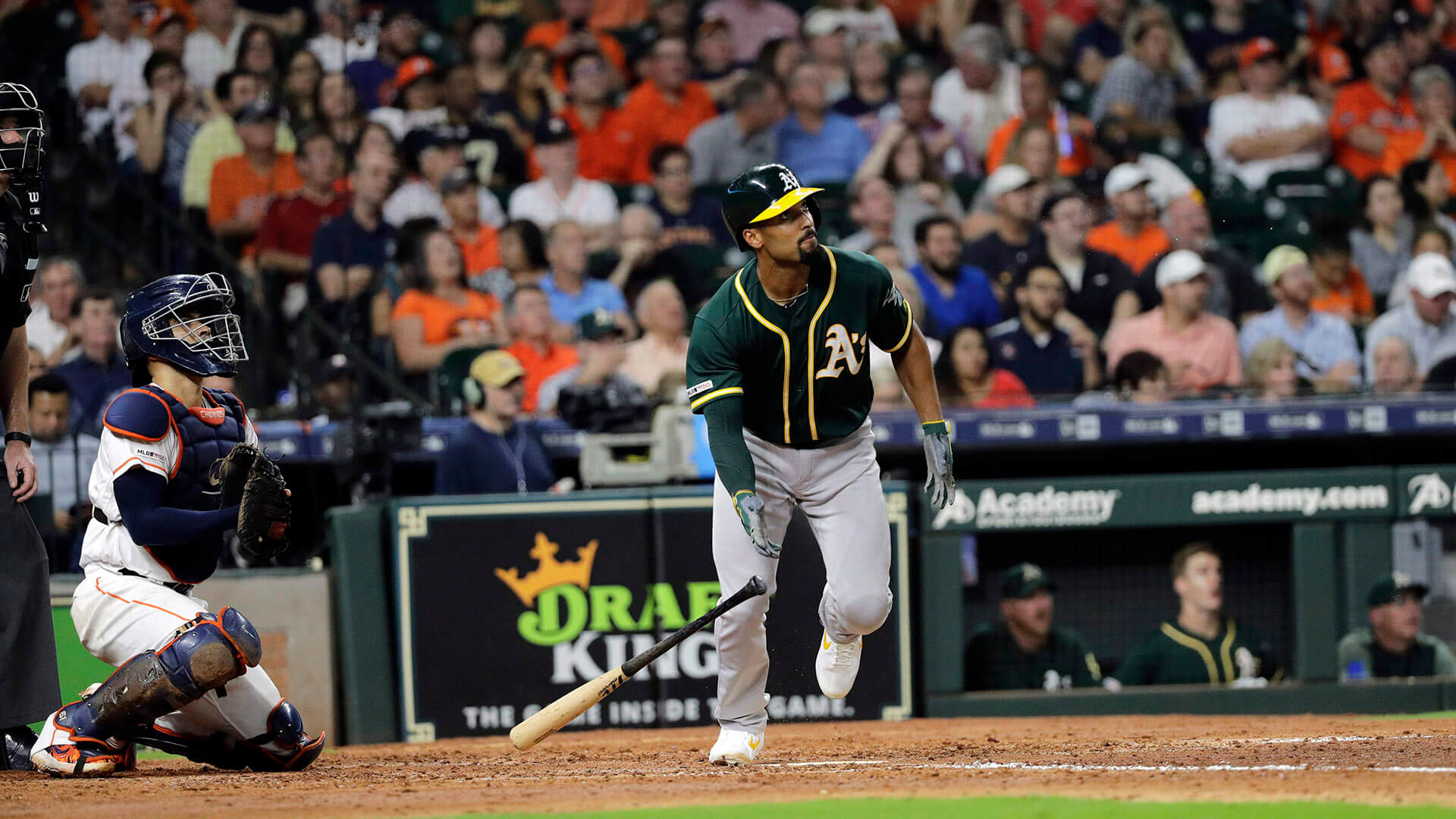
Not even named an all-star In July, Semien finished third in American League MVP voting and led all MLB shortstops in WAR. He carried Oakland to a second consecutive 97-win season and a return to the AL wild-card game, which he led off with a line-drive single up the middle. Suddenly, Semien was getting written up nationally. MLB Network wanted sit-downs. After being a 96 OPS+ hitter over his first six seasons, he put up a 140 in 2019. Many said it came out of nowhere. It didn’t.
Semien’s 2019 was an accumulation of sweat equity and adjustments compounding over years that all came together at once. As MLB pitchers continued throwing harder and harder during his early seasons in Oakland, Semien incorporated more high-velocity batting practice into his routine. He began hitting hard curveballs and sliders shot out of pitching machines. He asked Buscovich to stop drilling him with flips from a knee during batting practice and throw him everything overhand, everything harder. Buscovich began tossing to him from behind an L-screen positioned only 10–15 feet from the plate, which gave Semien less time to react and forced him to stay short and compact to the ball. He looked closely at how he was being attacked in pitcher’s counts, and altered his approach to be able to lay off or foul off tough two-strike breaking pitches and get to heaters up in the zone, which is where his power is.
“He was starting to really understand how guys were pitching him. He really dove into it and figured out a way to counter them back,” Flemer says. “Man, he researches everything. He understands scouting reports. He understands how to watch video the right way. He understands what to look for in his swing. He was really intensely analyzing all that stuff. And you could tell that lightbulb turned on for him. He was like, ‘Oh, okay, I think I figured it out now.’”
As his evolution continued, Semien began experimenting with different set-ups, different cues, even different bats. Midway through his supernova 2019, Semien switched from a 34-inch bat to the 33.5-inch one he’d messed around with during long cage sessions with Buscovich the previous winter. He felt like he could better control its barrel. Then he took it a step further, lessening the weight of his bat from 34 ounces all the way down to 31.5, which let him get around quicker against high velocity. Now, when he’s hitting over the winter, Semien will use his old heavy bats for tee work and close-range flips, before switching to smaller, lighter models when Buscovich moves back and starts feeding pitching machines to ramp up the heat.
“What’s important for me is just the consistency of my work. How I’m hitting in the cage and BP — how I feel and how my timing feels in the game. That stuff is the foundation of why I do well or why I don’t,” Semien says. “I’ll change something week-to-week if something doesn’t feel right. That’s the benefit of being an everyday player. You get to go out there and try something.”

Semien used to think he got to the ballpark pretty early. He’s usually rolling in somewhere around six hours prior to first pitch, which gives him enough time to get his insanely meticulous pre-game routine in before first pitch. But then he met Randal Grichuk. The Blue Jays outfielder came up in a Los Angeles Angels organization where there was a strict spring training rule about who could use the weight room and when. Minor-leaguers and early-career MLBers had to be in and out before any of the veterans got there. And you did not want to violate that rule. So, much to Semien’s surprise, when he arrived bright and early for his first day of camp with the Blue Jays this spring, Grichuk was already there. Thus began an only half-joking competition between the two throughout camp to see who could beat the other to the ballpark. “Grichuk’s always first,” Semien admits, defeatedly. “Getting here early is something that’s important for me. Get my body ready, get some food, and prepare yourself for the day. I really do enjoy that process.”
Semien’s enjoyed his brief time with the Blue Jays in general. He’s found an environment where he can continue mentoring young players like he did in Oakland, while learning from likeminded veterans such as Grichuk and George Springer. One where he’s playing every day up the middle of the diamond and, most importantly, winning. These are the goals that drove him through all those early mornings at the Coliseum this off-season, when Buscovich encountered a more motivated Semien than he’s ever seen. “I’d get in there and see four plates on either side of the bar and ask him, like, ‘Who’s putting up all this weight?’” Buscovich says. “He must have told me at least 30 times that this is the strongest he’s ever felt. He was really motivated; he was grinding all winter.”
Part of that has to do with how 2020 went. When COVID-19 shut down MLB facilities last spring, forcing players to make their own training arrangements, Semien’s cherished rhythm was completely thrown off. He tried to get his hands on whatever equipment he could, piecing together a rudimentary weight room in his garage. Some mornings, he would drive an hour from his home in Alameda, Calif., to a facility Buscovich had access to in Livermore, Calif., just to get some batting practice in. When MLB resumed in July, Semien already wasn’t feeling his best. Then he picked up an oblique issue during Oakland’s abbreviated summer training camp that only got worse as time went on. The .202/.256/.339 line he put up over his first 29 games reflects just how much it was impacting him. A year prior, Semien hit eight home runs in August and eight more in September. In 2020, he didn’t hit eight all season.
At one point, it got so bad he couldn’t take batting practice prior to games, opting instead to spend his time on the trainer’s table getting treatment. Minutes before a game began, he’d take 15 swings in an indoor batting cage just to get loose and then step on the field to face the best pitching in the world. He was still carrying the injury come October, and reaggravated it during Oakland’s divisional series with the Houston Astros while reaching out trying to grab a blooper hit over his head. “I’ve been a player who tends to play through certain nagging things. I understand how my body works,” he says. “I just wanted to be out there. I wasn’t 100 per cent. But I felt like I could do something to help the team.”
This is what Semien does — he plays hurt. He’s spent time on the injured list only once, in 2017, when he underwent surgery to repair a fractured scaphoid bone in his right wrist. Of course, he tried to play through that, too. He picked up the fracture in spring training. And it wasn’t until 11 games into Oakland’s season, with Semien having played every single inning at shortstop, that he accepted the inevitable and underwent the operation. When he finally returned to competition 10 weeks later, he walked and scored in his first plate appearance, and clubbed a line-drive single in his third. He started all but three of Oakland’s remaining 77 games.
Wise or not, it’s been this way his entire career. Only 20 MLBers have taken more trips to the plate than Semien since 2015. Only 10 have played more defensive innings. As he blitzkrieged through 2019, Semien led baseball with 162 games played and 747 plate appearances. He missed only 29 of the 1,465 defensive innings Oakland played. And eight of them came on the final day of the season, when he led off the top of the first to get his 162nd start and was immediately lifted.
Now in his 30s, he’s still doing it. When the Blue Jays went up by a couple touchdowns on the Angels early in a Saturday night game this April, with the club in the midst of a grueling 16-games-in-16-days stretch, Montoyo asked Semien if he wanted the rest of the night off. He wouldn’t take it. Bichette, a 23-year-old in his third MLB season, got the early hook instead, with Semien taking over at shortstop in his place. “I know so many guys who would’ve said, ‘Hey, I’m out,’” Montoyo says. “That’s not who he is. He wants to play every inning. He’s one of the most professional players I’ve ever been around.”
And he can’t stop now. For Semien, the 2021 season is about proving he can be his 2019 self again — or at least something close to it. There’s so much riding on it. Toronto’s post-season hopes, for starters, not to mention Semien’s earning potential when his contract’s up at season’s end. Not that he needs external motivation. Those who know Semien best say that beneath that calm, poised exterior he’s intensely competitive with himself — hungry to see the next pitch better than the last, to make every batting practice repetition count. Buscovich thinks it has something to do with where he’s from.
“For Marcus, growing up in El Cerrito — it’s not the easiest neighbourhood to grow up in,” Buscovich says. “It’s a ‘You eat, or you get eaten’ type of mentality. You’re always competing. You’re always trying to win a spot. I feel like it teaches you how to continue to just grind out the process. You really have to work for what you get.”
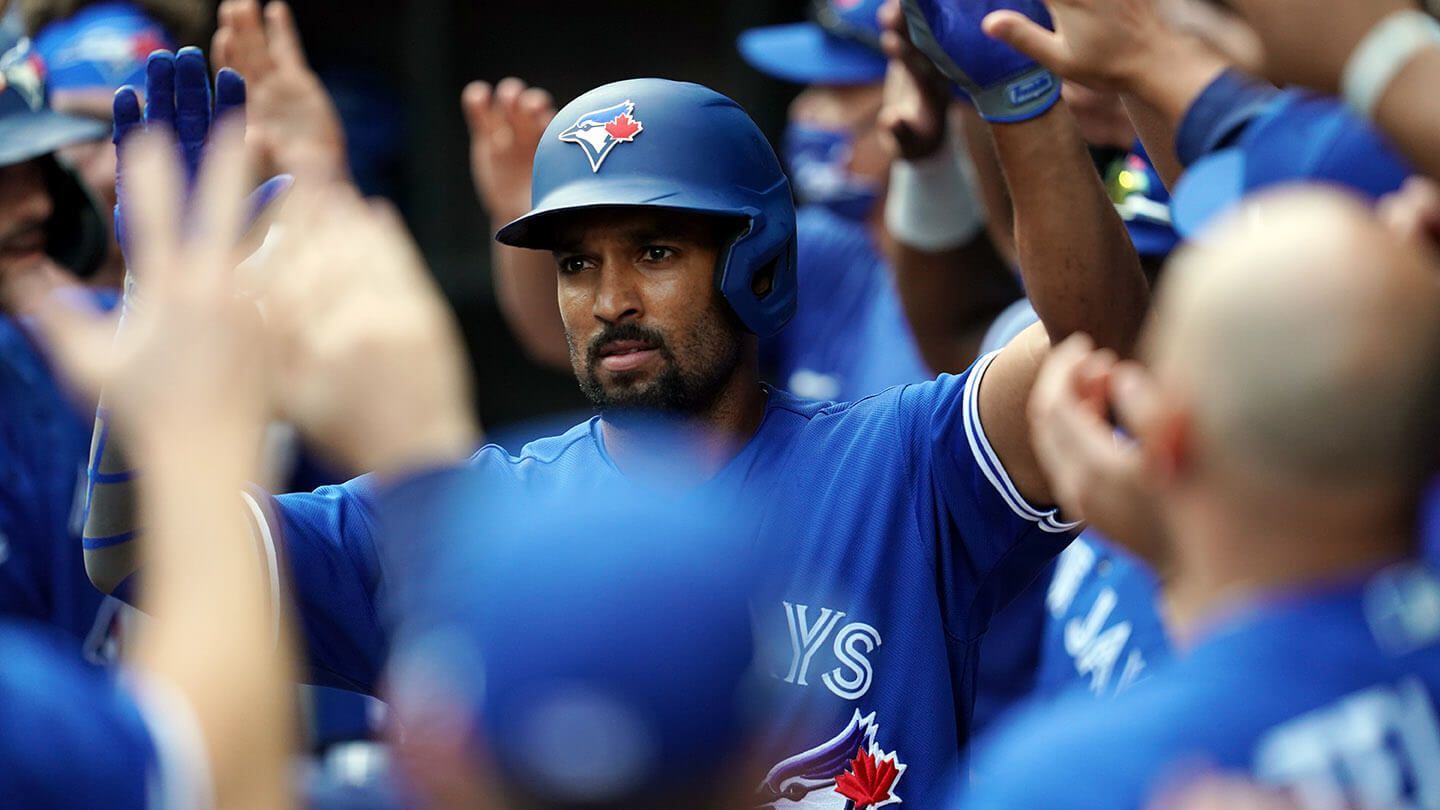
Monday night, Marcus Semien will dig his right toe into the familiar brown dirt next to home plate at RingCentral Coliseum, look out towards that big, Sacramento State green batter’s eye, and try to do damage against his hometown team. It’ll be weird, no doubt. And busy. Seeing his old teammates, all his family, all his friends, all the ordinary people ballplayers come in contact and build relationships with — security guards, clubbies, parking lot attendants — over a half-dozen years of daily interaction. Everyone will want their moment with Marcus. And then another game will begin. “It’s always kind of an uncomfortable feeling when you’re facing a guy you played with for six years,” Semien says. “But, you know, it’s still baseball. We’re still trying to win a ball game. And you need to have a certain mindset out there to do that.”
For Semien, that’ll mean feeding off the fire burning beneath the surface — the emotion he’ll never let any of us see. It’ll mean studying a pitcher early in the day, getting to the ballpark before just about everyone, and nailing his pre-game routine. It’ll mean remaining stoic and composed when failure inevitably materializes between the lines. It’ll mean scanning the crowd for Tarah and the boys in that moment, remembering that they’re watching, remembering the example he wants to be.
The difference for these three games is he’ll see more than just them looking on. He’ll see his parents, aunts, uncles, cousins, friends. He’ll see a community he’s been a part of his entire life and that he hasn’t been away from for this long in years. He’ll see Buscovich, who will wake up at the crack of dawn to train as long as his buddy’s playing big-league ball. And Flemer, his off-season golf partner and best friend for more than two decades.
That’s the circle he’ll keep when he’s back in town for good someday, done playing and ready to move on to other things, like watching Isaiah, Joshua and Eli embark on athletic careers of their own. Semien’s already talking about wanting the boys to go to St. Mary’s like their parents did. “I was like, ‘Dude, what do you mean? You don’t even know where you’re going to be living when that time comes,’” Flemer says. “He didn’t flinch. He’s like, ‘Oh, we’ll make that happen.’ That’s just the way he looks at it. The community’s helped him so much. So, he’s determined to keep that as part of his family now.”
It’ll start soon. As California schools continue reopening in the coming weeks, Tarah and the boys will return to Alameda so Elijah can begin kindergarten. The separation won’t be ideal. But it’ll be easier, certainly, than homeschooling while everyone follows Semien to Buffalo and eventually, maybe, Toronto. There’s family in the Bay Area. They can help out. And Dad has a season to focus on. A one-year, prove-it contract to fulfill. A club to help back to the post-season. Twenty-five teammates counting on him. How he plays over these next five months will go a long way to determining where he plays in years to come. But for this week, at least, it’s time to go home.


